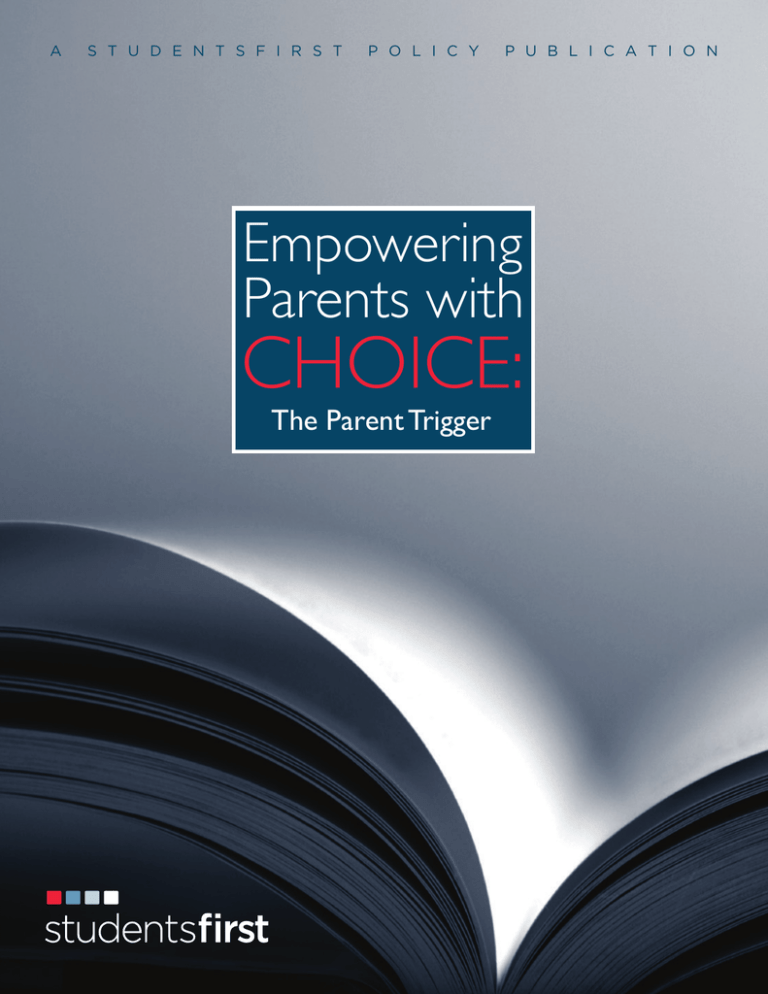
A
S T U D E N T S F I R S T
P O L I C Y
P U B L I C A T I O N
Empowering
Parents with
CHOICE:
The Parent Trigger
Empowering Parents with Choice:
The Parent Trigger
Parents of students in failing schools often feel powerless to give their children a better education.
StudentsFirst believes strongly in the need for policies that empower parents to improve the educational
opportunities available to their children.
In order to ensure a high-quality education for all students, it is critical that parents are empowered with tools
to demand change for their children’s education. Because parents naturally put the interests of their children
above the interests of the system, the more power parents can exercise over their children’s education, the
more likely we will be to build a student-centered education system.
What Is the Parent Trigger?
The parent trigger is a revolutionary idea that empowers parents to sign a petition to turn
around persistently low-achieving schools. It allows a majority of parents to mobilize
together and sign a petition demanding change. Typically, parents can petition to implement
one of the four federal Race to the Top intervention models at their children’s school,
although some states have introduced legislation modifying the reform options available to
parents.
THE FOUR FEDERAL INTERVENTION OPTIONS INCLUDE:
S
CLO
ED
S
CLO
ED
PUBLIC
CHARTER
S
CLO
ED
PUBLIC
CHARTER
PUBLIC
CHARTER
S
CLO
TURNAROUND MODEL A school district must make specific changes such as
replacing the principal, providing principals with greater decision-making flexibility, and
rehiring no more than 50% of existing staff, and other strategies.
RESTART MODEL The school is converted or closed and reopened as a public
charter school.
SCHOOL CLOSURE The school is closed and the students are enrolled at other
schools in the district that are higher achieving.
TRANSFORMATION MODEL A school district implements similar strategies
to the turnaround model such as focusing on increasing effectiveness in teachers and
leaders, utilizing comprehensive instructional reform strategies, increasing learning time, or
increasing operational flexibility. The principal could also be replaced under this option.
ED
PARENT TRIGGER
A
S
T
U
D
E
N
T
S
F
I
R
S
T
P
O
L
I
C
Y
P
U
B
L
I
C
A
T
I
O
N
The Parent Trigger Is A Transformational Policy
The parent trigger is a transformational policy for three major reasons:
1
1
1
2
2
It provides parents with more power and more options when it comes to
the education of their children.
Rather than being without options while their children are trapped in low-
performing schools, parents have the opportunity to engage directly in overhauling
their children’s schools by working with other parents to sign a petition and force a change.
Low-performing schools can be held accountable to the needs of the
families they serve.
3
2
3
Historically, parents have not been provided with many opportunities for input in their
children’s education beyond attending PTA meetings and doing some volunteer work.
If their children’s school is failing year after year, parents typically have very few - if
any - tools to change it. With the parent trigger, parents can mobilize together to hold
schools accountable for their students’ performance.
3
The parent trigger gives families leverage where they don’t otherwise have it
by increasing pressure upon districts and others in charge of failing schools.
Parents of children stuck in schools that are consistently the worst performing
can utilize the parent trigger to influence and impact decisions being made by the
governing body of the school. It provides an opportunity for schools and parents
to collaborate and improve our education system. In cases where the district or
school board is not willing to collaborate, parents can use the parent trigger to bring
unyielding governing bodies to the table to discuss reform options that can improve
schools, rather than just waiting and hoping for change.
Important Elements to Consider in
Parent Trigger Legislation
StudentsFirst believes that, if modeled correctly, the parent trigger can provide parents with
a new tool to influence and demand change in the type of education their children receive
and deserve. Thus, when it comes to determining the most important elements to include
in legislation, StudentsFirst believes:
The parent trigger should only be available to parents or legal guardians of children
attending schools that are consistently low-performing and ranked in the bottom 20% of
schools as identified under state law.
The purpose of the parent trigger is to empower parents of students stuck in
poorly performing schools to demand and force change where that momentum
is demonstrably lacking otherwise, rather than allowing parents of students at all
schools – including those attending excellent schools – to utilize it for reasons
other than improving academic achievement.
In addition to the parents or legal guardians of children attending or eligible to attend
a chronically failing school, the parents or legal guardians of children attending feeder
schools should also be eligible to sign a petition.
The parents of children attending schools that feed into persistently lowestachieving schools should have a say in the type of education their children will
receive in the near future.
PARENT TRIGGER
E M P O W E R I N G
P A R E N T S
W I T H
C H O I C E :
P A R E N T
T R I G G E R
A petition to turn around a failing school should be signed by parents or legal guardians
representing at least a majority of students attending the school.
Requiring parental signatures to represent at least a majority of students ensures a
democratic process and prevents a minority interest from having too much power.
Parents should be able to choose from all four federal intervention models, including
converting the school to a public charter school.
Parents should have more choices when it comes to the type of education their
children receive. Therefore, it is important that parents have the opportunity to
choose from one of the four federal Race to the Top options for their child’s
school if they are triggering a turnaround.
If the charter conversion option is selected, the public charter school established
should be subject to the same accountability and other standards in place for
public charter schools in that jurisdiction.
If parents choose the charter conversion option, their school district must ensure that the
parents choose a high quality charter operator.
If parents choose to convert their school to a charter school, it’s critical that the
charter operator they select has a track record of success. This will help ensure
that students receive a better education in their school after the parent trigger.
Districts can make this happen by requiring that any charter operator that takes
over a school as a result of parent trigger already has a number of schools in its
portfolio that are producing great results for kids.
The state department of education should be responsible for developing and issuing
regulations guiding the petition and petition process within 120 days of passage of the law.
In order for the parent trigger law to be effective, regulations surrounding the
petition format and petition process need to be established. Oftentimes, this
process can be dragged out, negatively affecting the implementation of a law.
Therefore, it is important that proposed legislation include a timeline for putting
into place regulations for the petition, including the appeals process. The state
department of education should be responsible for establishing the regulations and
should do so within 120 days from passage of the law.
If the restart model is selected, the state superintendent should approve the
selection of the public charter school, charter management organization, or
educational management organization that will take over the school.
The timing for the local educational agency to verify signatures and reach a decision
regarding the petition should be specified in order to ensure that action is taken in a timely
and effective manner.
Parents cannot afford to wait for their children’s education to get better. Every
day counts. By requiring the local educational agency to have 45 days to verify
signatures and no more than 30 days to subsequently make a decision on the
petition, parents can be sure that they are not being ignored and that their petition
is not unreasonably delayed.
Parents should be able to appeal the decision of a school district if it decides, in writing, to
implement a different option than requested.
When parents organize together and petition for change, they are doing so in order
to demand that their children receive the best possible education. If it is logistically
impossible to implement the option requested and the local educational agency
selects an alternative, it must notify parents in writing and present their decision at
a public meeting. These steps increase transparency and ensure accountability. The
local educational agency should also be required to notify the state superintendent
that the alternative option selected has substantial promise in enabling the school
to make adequate student achievement growth consistent with state standards.
Moreover, parents should have the opportunity to appeal the decision to the state
department of education if this scenario occurs.
PARENT TRIGGER
A
S
T
U
D
E
N
Parent Trigger
in California
In January 2010, California
became the first state in
the nation to sign parent
trigger legislation into law,
empowering parents to trigger
the turnaround of a failing
school. Community organizers
in California introduced this
innovative idea to shift power to
the parents of children stuck in
chronically failing schools. The
California parent trigger allows
a majority of parents whose
children attend a persistently
lowest-achieving school to sign
a petition requesting one of the
four federal Race to the Top
intervention options. These
options include bringing in a
new school leader, putting the
school under the management
of a high-performing public
charter school, closing the
failing school, or implementing
other strategies under the
turnaround or transformation
models. Both parents of
children currently enrolled in
the low-performing school and
parents of children slated to
eventually go to that school are
eligible to sign the petition.
T
S
F
I
R
S
T
P
O
L
I
C
Y
P
U
B
L
I
C
A
T
I
O
N
MCKINLEY ELEMENTARY SCHOOL - COMPTON
The city of Compton was the first city in the country to implement the parent trigger. On December
7, 2010, parents at McKinley Elementary in Compton, CA made history when they marched down to
their school district headquarters and submitted a parent trigger petition to transform their children’s
failing school.1 Because of illegal actions and desperate attempts from Compton Unified to preserve
the status quo and throw out the parents’ petitions, McKinley were not able to transform their own
school through their petition; many parents, however, ended up enrolling their children in a charter
school run by a high-performing charter operator just two blocks away from McKinley. These parents
McKinley started a movement of parents standing up for their children across California.
DESERT TRAILS ELEMENTARY SCHOOL - ADELANTO
In January 2012, parents of students enrolled in Desert Trails Elementary School in Adelanto,
California submitted a petition to their school board to convert Desert Trails into a charter school.
Seventy percent of the parents whose children attended Desert Trails had signed the petition and
the signatures were gathered through a grassroots, door-to-door campaign in which the surrounding
neighborhoods of Desert Trails were canvassed in order to gain support for the school turnaround.
Desert Trails has been classified as a failing school by the State of California for the past six years and,
according to state test results, 72% of sixth graders at Desert Trails were not proficient in English and
70% were not proficient in math. Furthermore, annual data shows that student achievement at Desert
Trails was decreasing rather than improving.
The parent trigger petition was initially rejected by the Adelanto School Board because there was a
question of whether all of the parents who had signed the petition had intended to sign it, but, in July
2012, a California trial court ruled that the original parent signatures were valid and that the parents
of students attending Desert Trails could begin the process of selecting a charter school operator.2
Desert Trails Preparatory Academy, the first school in the country to re-open after a successful parent
trigger campaign, welcomed its first class of students in August 2013.
24TH STREET ELEMENTARY SCHOOL – LOS ANGELES
In January 2013, parents of students at 24th Street Elementary submitted a petition to turnaround
their struggling school using parent trigger. After much negotiating, parents and the Los Angeles
Unified School District (LAUSD) came up with a unique plan –LAUSD would continue to educate
students in grades K-4, and Crown Prep, a charter school operator, would run grades 5-8. The newly
named 24th Street Learning Center opened its doors to students in August 2013 with a new principal
and lots of new staff. An on-campus social worker will bring community services to the campus and
the school is working to provide English classes to parents.3 24th Street represents a new type of
district-charter collaboration.
WEIGAND AVENUE ELEMENTARY SCHOOL – WATTS
In May 2013, the LAUSD school board approved parents’ petition to turn around Weigand
Avenue Elementary using the transformation model, which replaces a school principal. Weigand’s
performance scores had been steadily decreasing and less than half of the students could read or
do math at grade level.4 Students at Weigand began the 2013-2014 school year with a new principal,
Joseph Prendez, and many new teachers (a considerable number of teachers chose to transfer to other
schools after the parent trigger took place). Both parents and staff members were represented on the
five-person panel that selected the Prendez to be principal.
As of the fall of 2013, California is the only state in which parents have used parent trigger to turn
around their schools – this is despite the fact that parent trigger laws exist in a number of states.
Hopefully, over the next year, parents in other states will be able to use parent trigger to turn around
their kids’ struggling schools.
1
http://parentrevolution.org/content/mckinley-elementary
2
Diaz, et al. v. Adelanto School District, CIVVS 1201650 (Cal. Super. 2012).
Charter partnership gives L.A. Unified school new name and outlook, Stephen Ceasar
http://www.latimes.com/news/local/la-me-0814-lausd-trigger-20130814,0,1481998.story
3
4
Parent Revolution
PARENT TRIGGER
E M P O W E R I N G
P A R E N T S
W I T H
C H O I C E :
P A R E N T
T R I G G E R
Momentum for Change as Legislation Allowing Parent
Petitions Sweeps the Nation
Other states have followed suit by recently enacting or proposing similar
parent trigger legislation, often based on that of California. To date, two
states –Texas, and Ohio – have passed strong parent trigger legislation
similar to that in California.
In June 2011, Texas enacted SB 738 allowing a majority of parents to petition and
change a failing school by repurposing it, allowing for alternative management, or
closing the school.5
Also in June 2011, Ohio approved a parent trigger pilot program for poorly
performing schools in the Columbus City School District. Governor Kasich’s
budget bill, HB 153, allows a majority of parents to petition to reopen the school as
a community school, replace at least 70% of the personnel, contract with another
operator, or turn the operation over to the Department of Education.6
Three other states –Indiana, Louisiana, and Mississippi – have passed more
limited versions of parent trigger laws, providing for some form of parent
empowerment that is either restricted to only charter conversion or that
requires consent of the school board. Today, fifteen additional states have
considered or are considering parent trigger legislation including Arkansas,
Colorado, Florida, Georgia, Maine, Maryland, Michigan, Minnesota,
Missouri, Nevada, New Jersey, New York, Oklahoma, Pennsylvania, and
West Virginia.
It is clear from the number of states considering parent trigger legislation
that the momentum behind this policy is growing. It is also clear, however,
that some modified or watered down versions of the policy may provide
little actual power to parents, and so it is important to maintain high
standards around these policies.
See text of SB 738 from the Texas 2011 Regular Session signed into law in June 2011. http://www.legis.state.
tx.us/BillLookup/History.aspx?LegSess=82R&Bill=SB738
5
See text of HB 153 (page 1041 for Section 3302.042) from Ohio’s 2010-2011 legislative session signed by the
Governor in June 2011. http://www.legislature.state.oh.us/bills.cfm?ID=129_HB_153
6
PARENT TRIGGER
A
S
T
U
D
E
N
T
S
F
I
R
S
T
P
O
L
I
C
Y
P
U
B
L
I
C
A
T
I
O
N
Moving Forward
In order to ensure a high-quality education for every child, especially those
trapped in failing schools, parents must be empowered to help improve
their children’s schools – this happens through the parent trigger policy.
Parents want the best for their children, and the parent trigger equips them
with the ability to demand it. Parent trigger is another way to hold schools
accountable and to work toward the essential goal of a great school and
education for every student. This type of radical community empowerment
must translate to improved outcomes for students. Like many solutions, the
conversions and changes resulting from the parent trigger must be held to
the same high accountability standards of student achievement. If a school
fails to produce the right results in terms of student performance, it should
not continue to be entrusted with educating kids.
As more states consider parent trigger legislation, it is essential to ensure
that parents truly have the power to force a change in a school. Recent press
reports mention cases where parent trigger legislation has been watered
down, preventing parents from actually having the power to petition for
change on their own. In order for the parent trigger to create the intended
impact, parents must have power to act and force a change without having
to wait around for bureaucracies and special interests to come around to the
idea. Without this, parents will be left with fewer options for their children’s
education and their children could continue being stuck in failing schools.
All students deserve the best education and the parent trigger provides
parents with the opportunity to make that happen.
Empowering Parents with Choice: Parent Trigger was written by Halli Bayer
Halli Bayer is a Policy Analyst with StudentsFirst, where she focuses on governance, parent empowerment, and socioeconomic integration.
Prior to joining the StudentsFirst Policy Team, she taught middle school English in Los Angeles. She earned her law degree from the George
Washington University and her master’s degree in secondary education from Loyola Marymount University.
PARENT TRIGGER
TO VIEW OR DOWNLOAD
STUDENTSFIRST POLICY PUBLICATIONS, JUST VISIT
WWW.STUDENTSFIRST.ORG/POLICY
ELEVATING THE TEACHING PROFESSION:
INCREASING TEACHER QUALITY
GREAT TEACHERS FOR EVERY CHILD:
A MATTER OF SOCIAL JUSTICE
ALTERNATIVE TEACHER CERTIFICATION:
CREATING PATHWAYS FOR EFFECTIVE TEACHERS
EMPOWERING PARENTS WITH QUALITY CHOICE:
SCHOOL CHOICE TODAY
EMPOWERING PARENTS WITH DATA:
SCHOOL REPORT CARDS
EMPOWERING PARENTS WITH CHOICE:
PARENT TRIGGER
CHANGE THE LEADERSHIP, CHANGE THE RULES:
IMPROVING SCHOOLS
THROUGH MAYORAL & STATE GOVERNANCE
COMMON CORE STATE STANDARDS
StudentsFirst is a bipartisan grassroots movement of more than 2 million citizens nationwide working
to ensure educators are valued for the critical role they play in kids’ lives, families have high-quality
school choices and a real say in their children’s education, and our tax dollars are spent wisely on what
works for kids. Led by former Washington D.C. Public Schools Chancellor Michelle Rhee, StudentsFirst
is active in 18 states and has successfully helped pass more than 135 student-centered policies across
the country. For more information visit www.studentsfirst.org.
825 K Street • Sacramento, California 95814 | T: 916.287.9220 | F: 916.842.3939 • studentsfirst.org
SEPTEMBER • 2013
©2013 StudentsFirst. All rights reserved.





